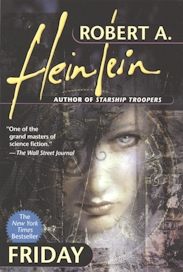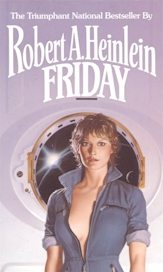
1982 Holt, Rinehart Winston
1st edition hardback
cover art by Richard M. Powers (left)
1997 Ballantine trade paperback
cover art by Cliff Nielsen (right)
both editions 368 pages

Denver Science Fiction & Fantasy Book Club |
 |
Friday (1982) 1982 Holt, Rinehart Winston 1st edition hardback cover art by Richard M. Powers (left) 1997 Ballantine trade paperback cover art by Cliff Nielsen (right) both editions 368 pages |
 |
 |
Another Book Cover: Friday (1982) Del Rey paperback (probably the most familiar book cover) cover art by Michael Whelan (left) |
| Dan | 8 | Amy | 7 |
 |
10 Wow! Don't miss it 8-9 Highly recommended 7 Recommended 5-6 Mild recommendation 3-4 Take your chances 1-2 Below average; skip it 0 Get out the flamethrower! U Unfinishable or unreadable - Skipped or no rating given |
| Cheri | 7 | Barb | 8 | ||
| Aaron | 7 | Cynthia | 8 | ||
| Jackie | 6 | Ron | 5 |
|
Aaron's Commentary
Robert A. Heinlein - Friday
Why does it seem that science fiction writers used to have more fun than they do now? This novel is not as ambitious as some of Heinlein's work, but you get a sense throughout that Heinlein was having a great time creating his protagonist and visualizing the near-future world she inhabits. There are admittedly some scenes where it is hard to know what the old man was thinking, notably when Friday tries to enjoy herself while being raped, but overall Friday works better than a lot of Heinlein's later work because he eased off the philosophizing and had fun with the story. While the plot is aimless at times, the novel still makes for entertaining reading. Friday is a wonderfully tough and resourceful yet feminine lady. She gets my vote for Heinlein's best female character. He drops the condescension he too often showed toward his women characters, and manages to engage fully with Friday's feelings and with her point of view. What do you think? Your comments are welcome. Please send them to vanaaron@excite.com |